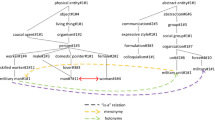Abstract
Semantic relatedness computation is the task of measuring the degree of relatedness of two concepts. It is a well known problem with applications ranging from computational linguistics to cognitive psychology. In all existing approaches, relatedness is assumed to be symmetric i.e. the relatedness of terms t i and term t j is considered the same as the relatedness of terms t j and t i . However, there are tasks such as free word association, where the association strength assumed to be asymmetric. In free word association, the given term determines the context in which the association strength must be computed. Based on this key observation, the paper presents a new approach to computing term relatedness guided by asymmetric association. The focus of this paper is on using Wikipedia for extracting directional context of each given term and computing the association of input term pair in this context. The proposed approach is generic enough to deal with both symmetric as well as asymmetric relatedness computation problems. Empirical evaluation on multiple benchmark datasets shows encouraging results when our automatically computed relatedness scores are correlated with human judgments.
Access this chapter
Tax calculation will be finalised at checkout
Purchases are for personal use only
Preview
Unable to display preview. Download preview PDF.
Similar content being viewed by others
References
Strube, M., Ponzetto, S.P.: Wikirelate! computing semantic relatedness using wikipedia. In: Proceedings of Association for the Advancement of Artificial Intelligence (AAAI) (2006)
Gabrilovich, E., Markovitch, S.: Computing semantic relatedness using wikipedia-based explicit semantic analysis. In: Proceedings of the 20th International Joint Conference on Artificial Intelligence, pp. 1606–1611 (2007)
Milne, D., Witten, I.H.: An effective, low-cost measure of semantic relatedness obtained from wikipedia links. In: Proceeding of AAAI Workshop on Wikipedia and Artificial Intelligence: An Evolving Synergy, pp. 25–30 (July 2008)
Zesch, T., Gurevych, I.: Wisdom of crowds versus wisdom of linguists, measuring the semantic relatedness of words. Nat. Lang. Eng. 16(1), 25–59 (2010)
Hassan, S., Banea, C., Mihalcea, R.: Measuring semantic relatedness using multilingual representations. In: Proceedings of the First Joint Conference on Lexical and Computational Semantics, Proceedings of the Main Conference and the Shared Task, Proceedings of the Sixth International Workshop on Semantic Evaluation, SemEval 2012, vol. 1, vol. 2, pp. 20–29. Association for Computational Linguistics (2012)
Navigli, R., Ponzetto, S.P.: Babelrelate! a joint multilingual approach to computing semantic relatedness. In: AAAI (2012)
Yazdani, M., Popescu-Belis, A.: Computing text semantic relatedness using the contents and links of a hypertext encyclopedia. Artif. Intell. 194, 176–202 (2013)
Halawi, G., Dror, G., Gabrilovich, E., Koren, Y.: Large-scale learning of word relatedness with constraints. In: Proceedings of the 18th ACM SIGKDD International Conference on Knowledge Discovery and Data Mining, KDD 2012, pp. 1406–1414 (2012)
Miller, G.A., Charles, W.G.: Contextual correlates of semantic similarity. Language and Cognitive Processes 6(1), 1–28 (1991)
Rubenstein, H., Goodenough, J.B.: Contextual correlates of synonymy. Commun. ACM 8, 627–633 (1965)
Finkelstein, L., Gabrilovich, E., Matias, Y., Rivlin, E., Solan, Z., Wolfman, G., Ruppin, E.: Placing search in context: the concept revisited. ACM Trans. Inf. Syst. 20(1), 116–131 (2002)
Hliaoutakis, A.: Semantic similarity measures in mesh ontology and their application to information retrieval on medline. Master’s thesis (2011)
Pedersen, T., Pakhomov, S.V.S., Patwardhan, S., Chute, C.G.: Measures of semantic similarity and relatedness in the biomedical domain. J. of Biomedical Informatics 40, 288–299 (2007)
Hassan, S., Mihalcea, R.: Semantic relatedness using salient semantic analysis. In: AAAI (2011)
Al-Mubaid, H., Nguyen, H.A.: Measuring semantic similarity between biomedical concepts within multiple ontologies. IEEE Transactions on Systems, Man, and Cybernetics, Part C 39(4), 389–398 (2009)
Lin, D.: An information-theoretic definition of similarity. In: Proceedings of the 15th International Conference on Machine Learning, pp. 296–304. Morgan Kaufmann (1998)
Jiang, J., Conrath, D.W.: Semantic similarity based on corpus statistics and lexical taxonomy. In: Proceedings of International Conference Research on Computational Linguistics (ROCLING), pp. 19–33 (1997)
Rada, R., Mili, H., Bicknell, E., Blettner, M.: Development and application of a metric on semantic nets. IEEE Transactions on Systems, Man and Cybernetics 19(1), 17–30 (1989)
Leacock, C., Chodorow, M.: ch. 11, Combining Local Context and WordNet Similarity for Word Sense Identification, pp. 265–283. The MIT Press (1998)
Resnik, P.: Using information content to evaluate semantic similarity in a taxonomy. In: Proceedings of the 14th International Joint Conference on Artificial Intelligence (AAAI), pp. 448–453 (1995)
Medelyan, O., Milne, D., Legg, C., Witten, I.H.: Mining meaning from wikipedia. International Journel of Human Computer Studies 67, 716–754 (2009)
Nelson, D.L., Mcevoy, C.L., Schreiber, T.A.: The University of South Florida free association, rhyme, and word fragment norms. Behavior Research Methods, Instruments, & Computers, 402–407 (2004)
Radinsky, K., Agichtein, E., Gabrilovich, E., Markovitch, S.: A word at a time: computing word relatedness using temporal semantic analysis. In: Proceedings of the 20th International Conference on World Wide Web, WWW 2011, pp. 337–346 (2011)
Author information
Authors and Affiliations
Editor information
Editors and Affiliations
Rights and permissions
Copyright information
© 2013 Springer-Verlag Berlin Heidelberg
About this paper
Cite this paper
Jabeen, S., Gao, X., Andreae, P. (2013). Directional Context Helps: Guiding Semantic Relatedness Computation by Asymmetric Word Associations. In: Lin, X., Manolopoulos, Y., Srivastava, D., Huang, G. (eds) Web Information Systems Engineering – WISE 2013. WISE 2013. Lecture Notes in Computer Science, vol 8180. Springer, Berlin, Heidelberg. https://doi.org/10.1007/978-3-642-41230-1_8
Download citation
DOI: https://doi.org/10.1007/978-3-642-41230-1_8
Publisher Name: Springer, Berlin, Heidelberg
Print ISBN: 978-3-642-41229-5
Online ISBN: 978-3-642-41230-1
eBook Packages: Computer ScienceComputer Science (R0)




